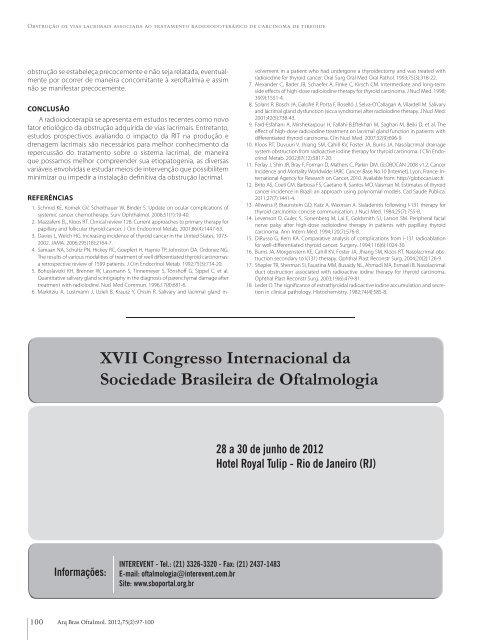São Paulo (SP) - Conselho Brasileiro de Oftalmologia
São Paulo (SP) - Conselho Brasileiro de Oftalmologia
São Paulo (SP) - Conselho Brasileiro de Oftalmologia
Create successful ePaper yourself
Turn your PDF publications into a flip-book with our unique Google optimized e-Paper software.
Obstrução <strong>de</strong> vias lacrimais associada ao tratamento radioiodoterápico <strong>de</strong> carcinoma <strong>de</strong> tireoi<strong>de</strong><br />
obstrução se estabeleça precocemente e não seja relatada, eventualmente<br />
por ocorrer <strong>de</strong> maneira concomitante à xeroftalmia e assim<br />
não se manifestar precocemente.<br />
CONCLUSÃO<br />
A radioiodoterapia se apresenta em estudos recentes como novo<br />
fator etiológico da obstrução adquirida <strong>de</strong> vias lacrimais. Entretanto,<br />
estudos prospectivos avaliando o impacto da RIT na produção e<br />
dre nagem lacrimais são necessários para melhor conhecimento da<br />
repercussão do tratamento sobre o sistema lacrimal, <strong>de</strong> maneira<br />
que possamos melhor compreen<strong>de</strong>r sua etiopatogenia, as diversas<br />
variáveis envolvidas e estudar meios <strong>de</strong> intervenção que possibilitem<br />
minimizar ou impedir a instalação <strong>de</strong>finitiva da obstrução lacrimal.<br />
REFERÊNCIAS<br />
1. Schmid KE, Kornek GV, Scheithauer W, Bin<strong>de</strong>r S. Update on ocular complications of<br />
systemic cancer chemotherapy. Surv Ophthalmol. 2006;51(1):19-40.<br />
2. Mazzaferri EL, Kloos RT. Clinical review 128: Current approaches to primary therapy for<br />
papillary and follicular thyroid cancer. J Clin Endocrinol Metab. 2001;86(4):1447-63.<br />
3. Davies L, Welch HG. Increasing inci<strong>de</strong>nce of thyroid cancer in the United States, 1973-<br />
2002. JAMA. 2006;295(18):2164-7.<br />
4. Samaan NA, Schultz PN, Hickey RC, Goepfert H, Haynie TP, Johnston DA, Ordonez NG.<br />
The results of various modalities of treatment of well differentiated thyroid carcinomas:<br />
a retrospective review of 1599 patients. J Clin Endocrinol Metab. 1992;75(3):714-20.<br />
5. Bohuslavizki KH, Brenner W, Lassmann S, Tinnemeyer S, Tönshoff G, Sippel C, et al.<br />
Quantitative salivary gland scintigraphy in the diagnosis of parenchymal damage after<br />
treatment with radioiodine. Nucl Med Commun. 1996;17(8):681-6.<br />
6. Markitziu A, Lustmann J, Uzieli B, Krausz Y, Chisin R. Salivary and lacrimal gland involvement<br />
in a patient who had un<strong>de</strong>rgone a thyroi<strong>de</strong>ctomy and was treated with<br />
radioiodine for thyroid cancer. Oral Surg Oral Med Oral Pathol. 1993;75(3):318-22.<br />
7. Alexan<strong>de</strong>r C, Ba<strong>de</strong>r JB, Schaefer A, Finke C, Kirsch CM. Intermediate and long-term<br />
si<strong>de</strong> effects of high-dose radioiodine therapy for thyroid carcinoma. J Nucl Med. 1998;<br />
39(9):1551-4.<br />
8. Solans R, Bosch JA, Galofré P, Porta F, Roselló J, Selva-O’Callagan A, Vilar<strong>de</strong>ll M. Salivary<br />
and lacrimal gland dysfunction (sicca syndrome) after radioiodine therapy. J Nucl Med.<br />
2001;42(5):738-43.<br />
9. Fard-Esfahani A, Mirshekarpour H, Fallahi B,Eftekhari M, Saghari M, Beiki D, et al. The<br />
effect of high-dose radioiodine treatment on lacrimal gland function in patients with<br />
differentiated thyroid carcinoma. Clin Nucl Med. 2007;32(9):696-9.<br />
10. Kloos RT, Duvuuri V, Jhiang SM, Cahill KV, Foster JA, Burns JA. Nasolacrimal drainage<br />
system obstruction from radioactive iodine therapy for thyroid carcinoma. J Clin Endocrinol<br />
Metab. 2002;87(12):5817-20.<br />
11. Ferlay J, Shin JR, Bray F, Forman D, Mathers C, Parkin DM. GLOBOCAN 2008 v1.2, Cancer<br />
Inci<strong>de</strong>nce and Mortality Worldwi<strong>de</strong>: IARC Cancer Base No.10 [Internet]. Lyon, France: In -<br />
ternational Agency for Research on Cancer, 2010. Available from: http://globocan.iarc.fr.<br />
12. Brito AS, Coeli CM, Barbosa FS, Caetano R, Santos MO, Vaisman M. Estimates of thyroid<br />
cancer inci<strong>de</strong>nce in Brazil: an approach using polynomial mo<strong>de</strong>ls. Cad Saú<strong>de</strong> Pública.<br />
2011;27(7):1441-4.<br />
13. Allweiss P, Braunstein GD, Katz A, Waxman A. Siala<strong>de</strong>nitis following I-131 therapy for<br />
thyroid carcinoma: concise communication. J Nucl Med. 1984;25(7):755-8.<br />
14. Levenson D, Gulec S, Sonenberg M, Lai E, Goldsmith SJ, Larson SM. Peripheral facial<br />
nerve palsy after high-dose radioiodine therapy in patients with papillary thyroid<br />
carcinoma. Ann Intern Med. 1994;120(7):576-8.<br />
15. DiRusso G, Kern KA. Comparative analysis of complications from I-131 radioablation<br />
for well-differentiated thyroid cancer. Surgery. 1994;116(6):1024-30.<br />
16. Burns JA, Morgenstern KE, Cahill KV, Foster JA, Jhiang SM, Kloos RT. Nasolacrimal obstruction<br />
secondary to I(131) therapy. Ophthal Plast Reconstr Surg. 2004;20(2):126-9.<br />
17. Shepler TR, Sherman SI, Faustina MM, Busaidy NL, Ahmadi MA, Esmaeli B. Nasolacrimal<br />
duct obstruction associated with radioactive iodine therapy for thyroid carcinoma.<br />
Ophthal Plast Reconstr Surg. 2003;19(6):479-81.<br />
18. Le<strong>de</strong>r O. The significance of extrathyroidal radioactive iodine accumulation and secretion<br />
in clinical pathology. Histochemistry. 1982;74(4):585-8.<br />
XVII Congresso Internacional da<br />
Socieda<strong>de</strong> Brasileira <strong>de</strong> <strong>Oftalmologia</strong><br />
28 a 30 <strong>de</strong> junho <strong>de</strong> 2012<br />
Hotel Royal Tulip - Rio <strong>de</strong> Janeiro (RJ)<br />
Informações:<br />
INTEREVENT - Tel.: (21) 3326-3320 - Fax: (21) 2437-1483<br />
E-mail: oftalmologia@interevent.com.br<br />
Site: www.sboportal.org.br<br />
100 Arq Bras Oftalmol. 2012;75(2):97-100

















